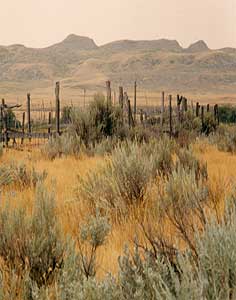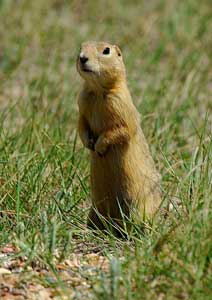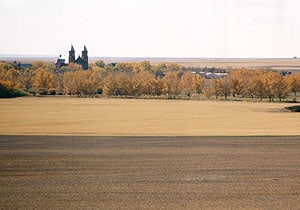Grasslands National Park: Canada’s Only Virgin Prairie
By Habeeb Salloum

As we drove westward from Regina, a city of some 200,000 and the province of Saskatchewan’s capital, my thoughts went back to my youth — the time I grew up in this part of Canada.
The prairie land through which we were driving, the small villages strung along railway tracts, and the farmhouses dotting the countryside in that period formed my world. I knew nothing beyond.
At that time, during the Depression years, it was a landscape of drifting sands and blowing winds driving Russian thistle and tumbleweeds to float across the arid countryside. It was a harsh world in which one had to truly struggle to survive.

Grasslands National Park
Our goal this day was the Grasslands National Park, a piece of Saskatchewan where the prairie land has been returned to its original state – before farmers and their plows had destroyed the work of nature, turning the countryside into a prairie desert.
What is Grasslands National Park known for?
I wanted to see what had been achieved with the land that our family had a hand in destroying when they, like other immigrants as homesteaders, plowed the virgin prairie soil.
Hints of Affluence
Now some three-quarters of a century later, as I looked around, the countryside looked much different than the days of my childhood. Rich-looking cultivated fields stretched as far as the eye could see.
People driving by looked prosperous and the countryside oozed hints of affluence. Paved highways crisscrossed the flat plains and modern machinery could be seen everywhere. As if by magic, my harsh vision of the landscape during the Depression years had evaporated as if it had never been.
The City of Moose Jaw
After driving for three-quarters of an hour we turned southward to the city of Moose Jaw. Passing the Wakamow Valley we drove on Highway No. 2 through rolling fields: some cultivated; others ranch land.
Some 110 km (68 mi) from Moose Jaw we entered Assiniboia — a small town of some 2,320 souls with neat well-maintained homes enhanced by planted trees and shrubs.
The town, fair-sized by Saskatchewan standards, was named after the Assiniboine indigenous peoples – its name in the ‘Plains Ojibwa’ meaning ‘One who cooks with heated stones’.
Soon we were driving on the wide main street edged by a wide variety of shops and other businesses, which cater to a large farm population in the surrounding countryside.

We then made our way to the Shurniak Art Gallery, which features a fine collection of paintings and diverse works of art by Southern Saskatchewan Artists.
The Red Coat Trail
After a light lunch in the Gallery’s Marita’s Tearoom, we left, driving westward on Highway 13 that follows the route known as the ‘Red Coat Trail’.
It is a part of a 1,300 km (807 mi) route that began near Winnipeg and ended near the Alberta border. It was the route taken in 1874 by the Northwest Red Coat Mounted Police in their journey to bring law and order to the Canadian West – hence its name.
The cool and invigorating cool prairie air, flowing through the open window, put us in an upbeat mood as we drove through a landscape of cultivated fields.
My enthusiastic colleague, surveying the scene, motioned with her hand, asking, “Look! It’s beautiful! In what other place in the world can one look for 30 miles and see nothing but fields?”
Only a Plaque Remains
Passing Ponteix, noted for its fine church, we came to where the town of Gouverneur once stood. It was the village my parents first came to as immigrants in the early 1920s but during the Depression, it slowly faded away and now only a plaque stands to remind the passer-by that here the town of Governeur once stood.

Turning southward on Highway 4 at the town of Cadillac, we drove for some 15 minutes when I turned to my colleague, “Three miles south of here was the land on which our family homesteaded. It’s like a dream thinking back to those harsh days! Our plowing the soil and picking the rocks all came to naught. Look! It’s all now pastureland.”
Val Marie, Gate to Grasslands National Park
Driving for half an hour more, we reached Val Marie, which acts as the gate to the Grassland National Park – Canada’s only virgin prairie, encompassing prehistoric badlands, lush coulees, rolling grasslands, weathered cliffs and wide river valleys stretching to the far horizon.
As we entered the small village of 137 inhabitants some 50 km (30 mi) from the US border I had a feeling of remembrance. During my youth, it was the huge city of which I would dream of when I thought about what was beyond our isolated farm.
Grasslands National Park Visitor Centre

Soon we were at Grasslands National Park Visitor Reception Centre discussing with Colette Schmidt, Communications Services Officer, the history and future of the park. She said that Grasslands National Park, was now only about 500 sq km (200 sq mi) in two un-attached sections: the Western Section following the Frenchman River Valley; and the Eastern Section of mountain uplands and badlands.
The Park will eventually cover 350 square miles as the federal government purchases the land on a willing-seller/willing-buyer basis. Appropriation of land is not in the works.
We began our exploration of Grasslands National Park, where Saskatchewan greets Montana, by strolling through a grass landscape covering most parts of the broad Frenchman River Valley.
Unlike the vast majority of the prairie lands today, here the rolling terrain with its untouched original grassland flora, emphasized by such plants as cactus flowers, creeping juniper, blue grama grass, lichens, mosses and sage, appears today much as it did when the first settlers trod the land.
The Park offers some 40 different types of grasses and innumerable native wildflowers and other plant species.
Rare and Endangered Species
Commonly seen animals in the park are the mule and the white-tailed deer, and the pronghorn antelope, but more importantly, also to be found in the park are a good number of rare and endangered animal species.
Some of these include Baird’s sparrow, burrowing owl, eastern short-horned lizard, ferruginous hawk, the loggerhead strike, peregrine falcon, sage grouse-burrowing owl, and the yellow-bellied blue racer.

Once the Park was the home of thousands of bison but they disappeared when these animals were nearly eradicated by the white hunters. However, in 2005 bison began to be released in the park and today 400-500 of them again can be seen roaming the park, thriving in the natural grasses and other plants on which their ancestors thrived. View the bison camera and see the animals in the watering hole.
The wind blowing through the wild grasses caressing our bodies carried a pleasant scent giving the pristine prairie land an aroma seemingly of magic allurement.
Bison Hunters
Brimming with contentment, I thought to myself, “No wonder this part of the prairies was one of the favorite bison hunting areas of the indigenous peoples.”

From their times there are to be found in the park today many arrowheads and other weapons, bison jump cliffs, medicine wheels, pottery, rubbing stones, sacred sites, 13,000 tepee rings, and ancient village ruins.
As a culmination of the history of the indigenous peoples in this part of the prairies, Sitting Bull took refuge in the area after the battle of the Little Bighorn in 1876.
Prairie Dogs
Our first stop that afternoon was at a prairie dog colony – one of the 14 huge densely populated towns in the park. Grassland is the only place on the prairies where the black-tailed prairie dogs still live in colonies in their native habitat.
A critical species in the natural prairie ecosystem, its existence supports the survival of the coyote, fox, and badger as well as numerous other endangered species. The elimination of these colonies also almost wiped out the animal species that depend on them for survival.
I remember as a child when no one worried about endangered species, trapping gophers, brothers to the prairie dogs, for their tails.
The farmers were always worrying about gophers destroying their fields with their endless burrows and they would pay us children one cent per tail for every gopher we trapped.

For us it was the only pocket money we ever earned, but for the prairie dogs and the animals that depended on them for survival, it was almost total elimination.
That day we explored a good part of the park glorying in a land that remains as it was, thousands of years ago – some like to call it the ‘Land of Living Skies’ while others label it ‘Where Heaven meets the Earth’.
It was a fine example of how man can not only destroy nature but return it to its natural state, that is if there is a will.
For More Information:
Grasslands National Park of Canada, Visitor Information, housing brochures, displays, cassettes and videos relating to the Park.
South Saskatchewan Field Unit
P.O. Box 150
Val Marie, Saskatchewan, Canada S0N 2T0.
Tel:306-298-2257. Fax: 306-298-2042.
E-mail: grasslands.info @pc.gc.ca

Prairie Wind & Silver Sage – Friends of Grasslands, a volunteer organization dedicated to assisting Grasslands National Park in its effort to promote the ecological integrity of native prairie landscapes. PO Box 83, Val Marie, Saskatchewan S0N 2T0.
E-mail: info@pwss.ca
Shurniak Art Gallery
122-3rd Avenue West, Box 1178
Assiniboia, Saskatchewan Canada S0H 0B0.
Tel: (306) 642-5292. Fax: (306) 642-4541.
Email: info@shurniakartgallery.com
Two Good Places to stay in Val Marie:
The Convent Country Inn, Val Marie: A nine-room abode Its restaurant is said to be the best for 100 km (61 mi) in any direction, is located in this once-abandoned convent that had been converted into a hotel. Robert and Mette Duncan, its owners, came from Canada’s Pacific province of British Columbia and bought and renovated it into a hotel/restaurant. website
E-mail: conventinn@sasktel.net
The Crossing Resort is an ideal place to stay when visiting Grasslands National Park.
Box 31, Val Marie, Saskatchewan, Canada S0N 2T0.
Tel: (306) 298-2295.
E-mail: the.crossing.ken@sasktel.net
- El Salvador: Mayan Ruins and Scenic Landscapes - January 14, 2022
- Enchanted in Jarabacoa, Dominican Republic - March 5, 2019
- Ugarit, Syria: The Place Where Alphabets Began - September 26, 2017





